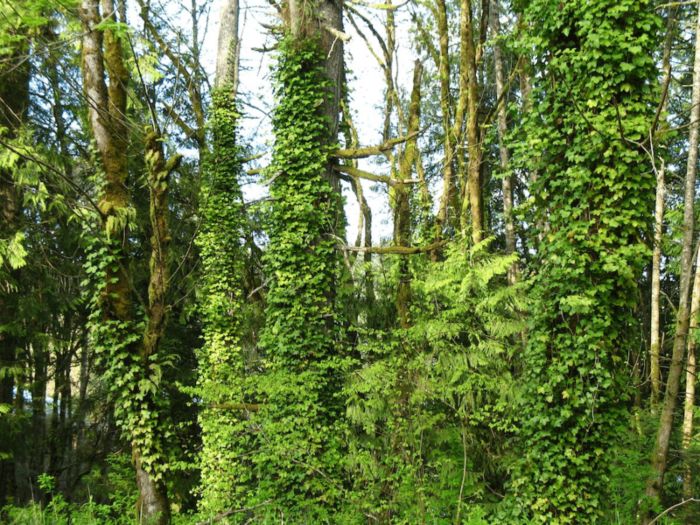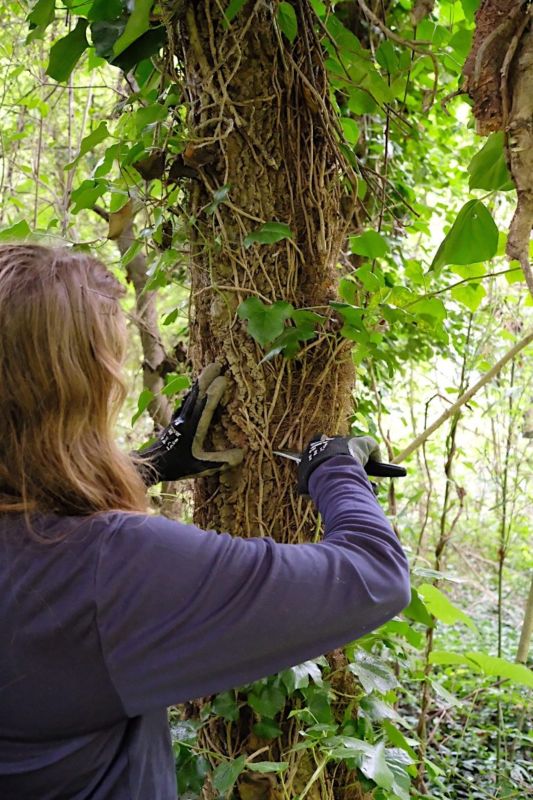English Ivy, with its lush green leaves and fast-growing vines, might seem like a charming addition to your garden or landscape. But beneath its appealing exterior lies a highly invasive plant that can wreak havoc on your local ecosystem and damage your trees. Want to know how to get rid of English ivy? Read on for more info on ivy, removal instructions, and top tips!
Why is English Ivy Invasive?
English Ivy is not native to North America and lacks the natural predators and diseases that control its growth in its native environment. This allows it to spread rapidly and outcompete native plants for resources. Its dense, evergreen foliage can smother other vegetation by blocking sunlight, reducing biodiversity and disrupting the balance of local ecosystems.
English Ivy takes over ecosystems by forming a thick ground cover that prevents native plants from germinating and growing. This ground cover also alters the soil composition, making it less hospitable for native flora. Furthermore, as it climbs trees and structures, it can overtake and kill other climbing plants and woody plants.

The Dangers of Removing Ivy
While it’s important to remove English Ivy to protect your trees, do so with caution. Improper removal can cause more harm than good. Ripping ivy off trees can damage the bark, leading to wounds that make the tree susceptible to pests, diseases, and decay.
How Can English Ivy Damage My Trees
- Competition for Nutrients: Ivy competes with trees for essential nutrients and water. This competition can weaken the tree, making it more vulnerable to other stresses such as drought or disease.
- Shading Out Sunlight: As ivy climbs up the trunk and branches, it forms a thick layer of foliage that can block sunlight from reaching the tree’s leaves. This shading reduces the tree’s ability to photosynthesize.
- Harboring Pests and Diseases: Ivy provides habitat for various pests and diseases. These organisms can move from the ivy to the tree, causing infestations or infections that further weaken the tree.
- Concealing Potential Decay and Structural Issues: Ivy can hide signs of decay, cracks, and structural problems in a tree. This concealment can delay the detection of issues, making them more severe by the time they are noticed.

Removing English Ivy – Step-By-Step
- Assess the Situation: Before starting, assess the extent of the ivy infestation. Determine if the ivy is primarily ground cover or if it has climbed trees.
- Prepare Your Tools: Gather gloves, pruning shears, a hand saw, and possibly herbicide (if necessary). Ensure you have protective clothing to prevent contact with ivy sap, which can be irritating to the skin.
- Remove Ground Cover Ivy: Start by pulling up the ivy on the ground. Use a digging tool to loosen the roots and pull them out by hand. Make sure to remove as much of the root system as possible to prevent regrowth.
- Cut Ivy on Trees: If ivy has climbed your trees, do not rip it off. Instead, cut the ivy stems near the base of the tree using pruning shears or a hand saw. Create a “life saver” ring around the tree by removing a section of ivy stems around the entire circumference.
- Let It Die: Allow the ivy above the cut to die naturally. This process may take a few weeks. The dead ivy will eventually lose its grip on the tree, making it easier to remove without damaging the bark.
- Remove Dead Ivy: Once the ivy is dead, carefully pry it away from the tree. Use gentle pressure to avoid damaging the bark.

Top 4 Tips to Remove English Ivy From Your Trees
- Don’t Rip Off Ivy: Ripping off ivy can cause significant damage to the tree bark. Always sever the ivy at the base and let it die before removal.
- Be Careful with Herbicides: If you choose to use herbicides, apply them carefully to avoid harming the tree or surrounding vegetation. Herbicides should be used as a last resort and according to the manufacturer’s instructions.
- Monitor for Resprouting: English Ivy can resprout from remaining roots. Regularly check the area for new growth and remove it promptly to prevent re-establishment.
- Contact a Professional: If the ivy infestation is extensive or you’re unsure about the removal process, get arborist consulting. Our Certified Arborists can recommend the best course of action for ivy on your trees. Plus, our team has the experience and tools to remove ivy safely and effectively from trees.





